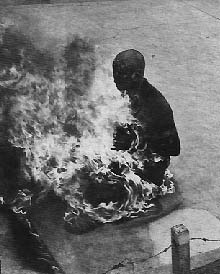
Buddhist monk immolates self in protest against Diem regime, 1963

Buddhist monk immolates self in protest against Diem regime, 1963
| Event | Date | Location | Significance
| Democratic Republic of Vietnam established | 1945 | Vietnam | With defeat and withdrawal of Japanese, Ho Chi Minh leads new state with 15,000 French soldiers present | Ho retreats to hills | 1947 | Vietnam | French seek to depose Ho who leads Viet Minh troops in opposition to French colonial presence
| French suffer huge defeat as 12,000 troops surrender and withdraw from Indochina | May 7, 1954 | Dienbienphu | Although U.S. paid 80% of French costs, Eisenhower refused to send troops to Vietnam
| Geneva Accords establish temporary division of Vietnam at 17th parallel | July 1954 | Geneva, Switzerland | Vietnam is divided into two nations with Ho leading the north and Ngo Dinh Diem leading the "free" South. Promise of free elections in 1956
| Diem opponents form National Liberation Front (NLF) | 1960 | South Vietnam | Communists and others attempt to overthrow Diem and unify Vietnam
| Diem overthrown and assassinated | November 2, 1963 | Saigon | With U.S. approval and support, Diem is replaced with military junta. 16,000 American military advisors in Vietnam
| Gulf of Tonkin Resolution | August 5, 1964 | Washington, D.C. | Following conflict between U.S. destroyers and North Vietnamese gunboats, Pres. Johnson is given authority to "prevent further aggression." Measure passes Congress 416-0 in House and 88-2 in Senate
| Johnson defeats Goldwater for presidency | November 1964 | U.S. | Portrayed as peace candidate, Johnson scores huge victory with 61% of the vote
| Johnson orders bombing of North Vietnam after attack at Pleiku kills 7 U.S. soldiers | February 1965 | Vietnam | In retaliation for Communist attack on U.S. unit, LBJ authorizes attack, but stops short of all-out bombing
| 20,000 U.S. troops sent to support South Vietnam | April 1, 1965 | Violating his promises, LBJ raises U.S. troop level to 100,000 to fight Viet Cong
| Tet Offensive begins | January 31, 1968 | Vietnam | Viet Cong forces launch massive attack on American positons throughout Vietnam. LBJ's popularity ratings drop to 35%
| My Lai Massacre | March 16, 1968 | Vietnam | Lt. William Calley leads unit which kills at least 175 unarmed Vietnamese civilians. Calley is later court-martialed and convicted, though none of his superiors are charged
| LBJ announces withdrawal from 1968 presidential race | March 31, 1968 | White House, Washington, D.C.
| Johnson announces end of bombing and calls for peace talks after embarassing performance in New Hampshire primaries | Paris Peace talks begin | May 1968 | Paris | Longest war in U.S. history begins winding down
| Nixon defeats Humphrey and Wallace | November 1968 | U.S. | Nixon wins with 43.4% of popular vote | U.S. begins secret bombing of North Vietnam and Cambodia | March 1969 | Nixon avoids antiwar protests by not telling Congress or people about bombings
| Nixon announces withdrawal of 60,000 U.S. ground troops | September 1969 | First reduction of U.S. troops since start of war
| U.S. troops enter Cambodia | April 1970 | Cambodia | Despite Nixon pledges that U.S. troops were withdrawing from Vietnam, Cambodia invasion and bombing brought huge domestic opposition
| Kent State Massacre | May 4, 1970 | Ohio | National Guard forces kill four students protesting Vietnam involvement
| Congress repeals Tonkin Gulf Resolution | June 24, 1970 | Washington, D.C. | In 81-10 vote, Senate repeals authorization of U.S. involvement
| Laos invaded | February 1971 | Laos | U.S. and South Vietnamese forces make incursion to "protect withdrawal of U.S. forces"
| Pentagon Papers released | June 1971 | New York | New York Times begins publication of secret war study
| North Vietnamese troops invade South | March 1972 | Vietnam | U.S. responds by widespread bombing of North, including bombing of Hanoi and mining of Haiphong Harbor
| Largest bombing of North Vietnam | December 17, 1972 | North Vietnam | American B-52s begin largest bombing of war, losing 15 B-52s
| Cease-fire accord achieved | January 27, 1973 | Paris | All fighting to stop and American prisoners of war to be released by North Vietnam
| Nixon resigns presidency | August 1974 | White House, Washington, D.C. | Under pressure from members of his own party, Nixon ceases fight over Watergate scandal
| North Vietnamese forces take Saigon | April 30, 1975 | Saigon, South Vietnam | Communist forces occupy South, renaming Saigon Ho Chi Minh City. U.S. troops evacuate American embassy as South Vietnamese flee | |
Please cite this source when appropriate:
Feldmeth, Greg D. "U.S. History Resources"
http://home.earthlink.net/~gfeldmeth/USHistory.html (31 March 1998).
 Back to Outlines & Charts Index
Back to Outlines & Charts Index
 Back to U.S. History Resources main page.
Back to U.S. History Resources main page.